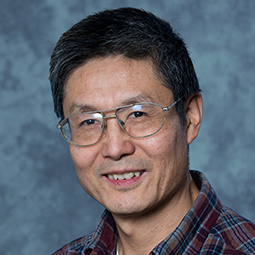Bioinformatics, Computational and Systems Biology
(B-46) Phenomena of cell migration in free space under osmotic pressure

Muriel Moon
Student researcher
University of South Carolina
Mukilteo, Washington, United States
Guiren Wang
Associate Professor, Mechanical Engineering, Biomedical Engineering
University of South Carolina, United States
Presenting Author(s)
Primary Investigator(s)
Cell migration is a fundamental biological process for many types of cell movement including immune response and is implicated in medical issues such as the migration of cancer cells from a primary tumor to other parts of the body. As a result, understanding cell migration is critical to identifying the underlying mechanisms of cell-migration related health issues including cancer metastasis. Previously, studies have observed that osmotic pressure (Stroka et. al.) and actin-driven cell motion (Zhang et. al.) are the fundamental factors for cell motion in confined 1-D and even 2-D spaces, where osmotic pressures drive cell movement as water flows out of the trailing edge and flows into the leading edge of the cell (Li and Lingxing). This mechanism has been extended to free space of solutions, where cells utilize the mechanism of actin-polymerization to move and theorizes that ΔPO-driven cell migration requires cell membrane deformation. However, we recently observed for the first time, to the best of our knowledge, that cell migration as a result of ΔPO still occurs in free space without requirement of deformation. To study the driving mechanism behind this observed cell migration, we tested the response of different types of cancer cells, both alive and dead, to varying levels of osmotic shock in free space. We found that by increasing osmotic pressure, proportionally increasing cell migration was observed in both lymphatic and breast cancer cells, supporting the theory that osmotic pressure is indeed a driving mechanism for 3-D cell migration when cells are in suspension.
Materials and Methods::
differing concentrations of 1X PBS buffer with a 26G needle that would cause differing levels of osmotic shock to reach cells. This small volume and setup was engineered to reduce any jet flow during injection but generate enough ΔPO to drive cell motion. Using both MDA MB-231 epithelial human breast cancer cells as adherent cell type and EL-4 T-lymphoblast mouse cancer cells as suspension cell type in petri dishes with 1X PBS buffer, 0.5ul injections with concentrations 0X, .25X, .5X, .75, and 1X PBS buffer were made, and videos were recorded using the IX-70 Olympus microscope camera at 4X for large view and 40X magnification for detail cell geometry. In this manner, injections with lower PBS concentrations resulted in experiments with larger ΔPO application to cells. Trypsinization was also performed on the MDA-MB 231 cells before injection in order to dissociate adherent cells into a suspended state.
Both to simulate particulate matter and to ensure that this osmotic pressure-driven cell migration was a function of living cells, a cell fixation experiment was performed on each of these cell types with 4% formaldehyde in order to kill them without destroying the wall or structure of the cells. Formaldehyde and cells were centrifuged together, and then washed three times with 1X PBS buffer. With these dead cells, the same injection procedure was followed. After data collection, all videos and cell movement were analyzed using the software ImageJ.
Results, Conclusions, and Discussions::
For both lymphatic cancer cells and breast cancer cells, injection of DI water—or 0X PBS buffer—resulted in cell migration to the point of injection. As seen in Figures 2 and 3, with increasing concentrations of PBS buffer—and therefore decreasing osmotic pressure on the cell—the velocity of cell migration to the point of injection decreased.
However, the epithelial breast cancer cells have adherent properties(Janiszewska et. al.), and cells that adhered to the petri dish in the time after trypsinization had no motion and were omitted from average velocity calculations.
Further, upon inspection of cell migration as a result of 0X PBS injection in 40X magnification(Figure 4), it appears that there is no deformation of the cell during migration.
For injections of 0X PBS onto dead cells, no cell migration was observed.
Based on the positive correlation between velocity of cell migration to the osmotic pressure, we conclude that water-driven cell migration does occur in a 3-D free space. This observed motion not only is consistent with the theorized mechanism of osmotic pressure-driven migration, but experimentally supports that living cells in suspension directly respond to osmotic pressure stress through cell migration. However, the role of cell deformation is not consisted with the theory. Because the epithelial MDA-MB 231 cells that adhered to the petri dish did not participate in cell migration, conclusions can be drawn about the difference between adherent MDA-MB 231 and non-adherent EL-4 cancer cells; the phenomena of cell migration of exclusively non-adherent cells may suggest that there needs to be further study into the role of epithelial cancer metastasis and its link to osmotic pressure. More specifically, to further study how mechanisms of osmotic pressure affect cell migration and cancer metastasis, future research may investigate how non-cancerous cells respond to osmotic shock.
Also, even though no cell deformation was observed during migration, cell deformation would be expected based on observations of cell migration in 1-D (Stroka et. al.). As a result, further research might investigate if this discrepancy can be linked to cell migration in suspension versus in 1-D, or if there is another system at work.
Acknowledgements (Optional): :
This experiment was constructed and facilitated by Dr. Guiren Wang and Dr. Qi Wang, and done in collaboration with Emma Bi.
This material is based upon work supported by the National Science Foundation under Grant No. 1852331.
References (Optional): :
Janiszewska, Michalina, et al. “Cell adhesion in cancer: Beyond the migration of single cells.” Journal of Biological Chemistry, vol. 295, no. 8, 2020, pp. 2495-2505, https://www.ncbi.nlm.nih.gov/pmc/articles/PMC7039572/#:~:text=As%20described%20above%2C%20loss%20of,of%20cells%20within%20a%20tumor.
Stroka, Kimberly M., et al. “Water Permeation Drives Tumor Cell Migration in Confined Microenvironments.” Cell, no. 157, 2014, pp. 611-623.
Yao, Lingxing, and Yizeng Li. “Effective Force Generation During Mammalian Cell Migration Under Different Molecular and Physical Mechanisms.” Frontiers, vol. 10, no. 903234, 2022, https://www.frontiersin.org/articles/10.3389/fcell.2022.903234/full.
Zhang, Y., et al. “Polarized NHE1 and SWELL1 regulate migration direction, efficiency and metastasis.” Nature Communications, vol. 13, no. 6128, 2022, https://www.nature.com/articles/s41467-022-33683-1#citeas.
